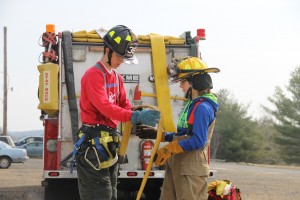By: Robert Avsec, Executive Fire Officer
The recruitment and retention of members is a critical issue for many volunteer fire departments across the U.S. and Canada.

Rick Markley
Fundamentally, the problem has “many moving parts” as outlined by Rick Markley in his Introduction to my recently published e-book, Essays on Recruitment and Retention for the Fire Service:
Recruiting and retaining outstanding firefighters is complicated. And Chief Avsec’s collection of essays on the subjects are neither the first nor the final word on it. It is an important, much-needed look at a complicated issue. And it is more than a series of alarm soundings; Chief Avsec provides some workable solutions from the field.
It can seem the forces of nature are conspiring against recruiting and retaining quality firefighters. In the volunteer sector, increased training requirements, job and family demands and a weakening sense of community have pushed their numbers so low many departments are faced with merger or closure.
A slowly recovering economy has left deep scars on municipal budgets, which has pushed many career firefighters to jump ship for better-paying departments. And poor leadership is cited across the board as a top reason firefighters are dissatisfied with the job.
Despite all of this, the fire service can still attract the best and the brightest. Yet it is critical we do not take our eye off the need to improve this aspect of the service.
Technology and engineering can put a man on the moon and a TIC on your SCBA. But it can’t fill your firehouse with great firefighters. That will take hard work, hard money and hard choices to move the ball farther down the field.
Chief Avsec’s essay collection will help you gain that valuable yardage.
Rick Markley
Volunteer Firefighter
Communications Director, International Firefighters Relief Mission
June 2017
Get the E-Book: Essays on Recruitment and Retention for the Fire Service (Available for Kindle and in PDF file format).
Here are some other blogs about Recruitment and Retention for the Fire Service that you may find useful, particularly for leaders of volunteer-staffed fire and EMS departments.
A New Paradigm for Volunteer Fire Department Recruitment
Management consultant and motivational speaker, John Maxwell, said, “What got you here, won’t get you there.” What I’ve written above outlines some of the more pertinent reasons why people don’t become volunteer firefighters, or why they leave their volunteer fire department. Regardless of a department’s size, volunteer fire department leaders must realize that recruitment and retention of members is most likely a systematic problem and not just an issue involving individual firefighters.
outlines some of the more pertinent reasons why people don’t become volunteer firefighters, or why they leave their volunteer fire department. Regardless of a department’s size, volunteer fire department leaders must realize that recruitment and retention of members is most likely a systematic problem and not just an issue involving individual firefighters.
Too many volunteer fire departments still recruit to fill the position of the “do-it-all firefighter.” Whether it’s implicitly stated or not, the message potential members “hear” is, “If you can’t do everything, then sorry, we just don’t have a place for you.”
Here are three ways to shift that paradigm to one that says, “Here are several ways you can meaningfully participate. Which ones suit you and your talents?”
How to Keep the Good Volunteer Firefighters You Have
Firefighters learn early in their training on the necessity for fuel, heat, and oxygen to combine in the proper measures for the chemical  reaction that we know as combustion or fire to occur. That process has been represented by the fire triangle: Heat, fuel, and oxygen.
reaction that we know as combustion or fire to occur. That process has been represented by the fire triangle: Heat, fuel, and oxygen.
I believe the same principle—combining elements to create a chemical reaction—can be applied by volunteer fire service leaders in creating an “atmosphere” within their organizations that supports motivation. I also believe a volunteer fire department that has a high level of motivation amongst its members is also one that’s not losing incumbent members.
My experiences as a fire officer lead me to believe that we can motivate another individual. We can teach people how to do their job safely, effectively and efficiently. We can provide a sound organizational structure with policies and procedures that are congruent with an organization’s vision, mission, and values. And we can attempt to modify undesirable individual behavior, when necessary, using progressive discipline. But I don’t think that we can make anyone do something that they don’t want to do.
Improving Response Times for Volunteer Fire Departments
What’s one of the most critical operational issues that many volunteer fire departments struggle with? Knowing who’s available for emergency responses and knowing who’s actually responding when a call for service comes in.
Volunteer fire departments have historically relied on sign-up sheets or boards located in the fire station; ad hoc scheduling at its best (or worst). And not always accurate as plans change for individual members, changes that too frequently don’t get made on the schedule.
In this article, I’m going to explore some options that volunteer fire departments can use to better ensure that they have the people they need when someone in the community needs their fire department.
 Fire & EMS Leader Pro The job of old firefighters is to teach young firefighters how to become old firefighters!
Fire & EMS Leader Pro The job of old firefighters is to teach young firefighters how to become old firefighters!